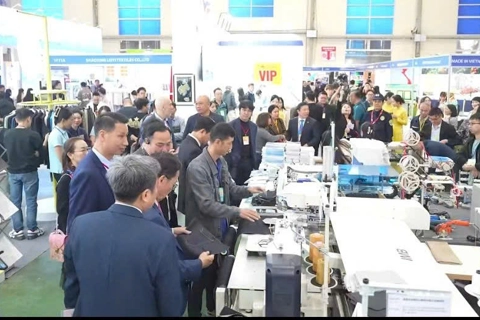Urbanization as growth engine for Red River Delta
The growth driver for the Red River Delta will be urban areas designed to foster an economic ecosystem encompassing industry, services, trade, and tourism.
Urbanization would serve as a key motor for growth in the Red River Delta region, one of the nation’s central hubs driving economic development.
| Deputy Prime Minister Tran Hong Ha at the meeting. Photos: Minh Khoi |
Deputy Prime Minister Tran Hong Ha shared the view at a meeting to discuss Red River Delta planning for the 2021-2030 period, with a vision for 2050.
According to a report from the consulting unit, the outlook for socio-economic development in the Red River Delta revolves around maximizing its potential and leveraging its outstanding advantages.
“The region would serve as a leading force, guiding and spearheading the nationwide process of economic restructuring and changing the growth model,” it said.
The foundation of this perspective lies in science, technology, innovation, and digital transformation, particularly in key economic sectors capable of propelling and leading the development of other sectors. The plan emphasizes comprehensive and effective international economic integration, capitalizing on opportunities from free trade agreements and new-generation investment deals to attract investments.
Furthermore, the plan outlines the necessity for balanced development between the economy and culture, society, environmental protection, climate change adaptation, and ensuring social security, and public order, as well as strengthening all-round national defense and people's security.
The developed infrastructure system in the Red River Delta is envisioned to be synchronized, multimodal, and modern, with a focus on inter-regional, inter-provincial, and international connectivity. This includes the construction of marine economic infrastructure, economic zones, industrial parks, free trade zones, and information and communication infrastructure, along with measures for irrigation and water source protection.
Urban and rural residential areas are to be organized in harmony with emerging production trends and urbanization, creating dynamic economic zones, strategic urban areas, international connectivity corridors, and regional and national links.
| Overview of the meeting. |
The long-term goal by 2030 is for the Red River Delta to achieve rapid and sustainable development, with a well-balanced economic structure and a robust national cultural identity.
The emphasis is on developing modern industries, high-tech services, and organic, green, and circular agriculture, while also positioning the region as a hub for education and high-quality human resources, leading in science, technology, innovation, digital transformation, and digital economy.
Environmental issues such as pollution, traffic congestion, and flooding will be fundamentally addressed, while defense and security are to be maintained. The plan envisions expanded foreign relations and effective international integration, ultimately improving the material and spiritual life of the people and positioning the region as a leader within the country.
The plan also aims to transform Hanoi into a "civilized - modern" capital, serving as the center and driving force for regional and national development, aspiring to reach the standards set by developed capitals in the region.
The target set is an average annual growth rate of around 9% for the total product in the region, with GRDP per capita reaching approximately US$11,000-12,000 by 2030.
Looking ahead to 2050, the vision for the Red River Delta is to continue leading the country in science and technology, innovation, digital economy, and digital society. Industries are expected to develop with advanced technology, meeting international standards and actively participating in the global value chain.
The plan envisions the formation of large regional and world-class service centers in trade, tourism, services, and logistics in key cities, along with the development of modern agriculture, ensuring a high standard of living for rural residents comparable to that of civilized cities.
| Red River Delta from above. Photo: Pham Hung/The Hanoi Times |
He expected the Red River Delta to take the lead in piloting innovative development models and new policies, to transform into a dynamic, modern, and high-income region by 2030.
Specific solutions and tasks are deemed necessary to address major challenges in regional development, such as the absence of production chains or industrial clusters in development corridors, unsustainable water resource usage, income disparities between southern and northern provinces, traffic congestion, flooding, air and water pollution, and the dependence of many localities on FDI for growth.
Other experts emphasized the importance of enhancing intra-regional and inter-regional connectivity, upgrading transportation infrastructure, relocating labor-intensive industries, and creating a chain of tourist destinations to spur growth.
Acknowledging, the complexity of planning the Red River Delta, Deputy Prime Minister Tran Hong Ha emphasizes the need for synchronization, unity, and avoidance of conflicts and overlaps with local plans, industry-specific plans, and field plans.
He underscores the role of the Red River Delta and the Southeast as the "development wings" of the country.
The growth driver for the Red River Delta will be urban areas designed to foster an economic ecosystem that includes industry, services, trade, and tourism.
Ha emphasized the need for effective policies to leverage land resources for the development of modern, green, and smart urban areas, with synchronized technical and social infrastructure to attract high-quality human resources.
Each locality in the Red River Delta region is urged to position itself as an economic, educational, medical, cultural, and tourism center.
"The Red River Delta is the cradle of culture, history, natural heritage, and humanity. Therefore, it is crucial to identify areas for preservation, conservation, restoration, and integration with tourism, creating balanced development highlights that harmonize tradition and modernity," Ha concluded.














